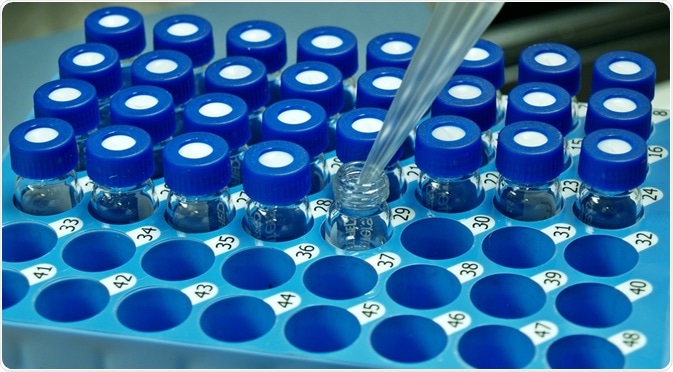Liquid chromatography coupled with tandem mass spectrometry (LC-MS/MS) is an advanced analytical chemistry technique that has many applications across the field of biology. LC-MS/MS has increased specificity over LC-MS alone and uses two mass spectrometers to further analyze ions via fragmentation processes.

Image Credit: Dermot McBrierty/Shutterstock.com
As recent advances have enhanced the technologies used in mass spectrometry and separation methods, LC-MS/MS has become more powerful and relied upon to perform qualitative and quantitative analyses on a variety of biological samples.
LC-MS/MS has been particularly useful in the areas of systems biology and biomarker discovery in analyzing proteomes by profiling protein expression levels.
Adding gels to the protocol
The use of 1D gels in combination with LC-MS/MS is an enhanced technique, known as Gel-LC-MS/MS or GeLC-MS/MS. The use of 1D SDS gels as a separation technique before conducting a bottom-up proteomic analysis is compatible with protein profile comparison approaches with methods such as; stable isotope labeling of amino acids in cell culture and label-free quantification.
Using gels in combination with LC-MS/MS has the benefit of fractioning complex samples before analysis, reducing the need for lengthy quantitative comparisons across many samples.
1D SDS gels can be used simply and quickly to fraction the sample, which is then stained, followed by the excision of appropriate gel slices, in-gel reduction, alkylation, and lastly protease digestion. The protein digests are then ready for LC-MS/MS analysis.
Performing LC-MS/MS analysis
The sample is prepared appropriately, usually through digestion, desalting, and other processes to interfering particulates.
Initially, the sample is separated via liquid chromatography. Nowadays, high pressure (or ultra-high pressure) liquid chromatography is used, these are cartridges where the sample is forced through at pressure to separate the molecules through different migration rates in the LC cartridge due to the chemical interaction between the components and the impacts of the stationery and migration phases of the cartridge.
The elutes from the LC cartridge are transferred to the mass spectrometer. For LC-MS/MS procedures the spectrometer is set up with a source of ionization to nebulize, desolvate, and finally, ionize the LC cartridge elute.
Under vacuum, the charged particles migrate through several mass analyzers which is done through applying electromagnetic fields. A known standard mass/charge precursor ion is passed through the first mass analyzer, this prevents all other mass/charge ratio particles from passing through.
Next, in the collision cell, the specific mass/charge ions collide with inert gas, this fragments the ions. The third mass analyzer is then used to target specific ion fragments.
An electron multiplier is used to quantify the resulting ions, transitioning them from the precursor to production. This process is specific to the compound of interest, meaning that the process is highly selective.
The method can be used for a wide range of samples and is highly sensitive and selective. These characteristics have made this technique an attractive method in identifying the compounds existent in the proteome.
As the proteins within a cell represent a function, studying the proteome is essential for gaining deeper insights into the function of the human body at the cellular level. Techniques that facilitate proteomic research will have a great impact on future research across many scientific fields.
Sources:
- Ahrens, C., Brunner, E., Qeli, E., Basler, K., and Aebersold, R. (2010). Generating and navigating proteome maps using mass spectrometry. Nature Reviews Molecular Cell Biology, 11(11), pp.789-801.
- Cutillas, P., and Timms, J. (2010). Approaches and Applications of Quantitative LC-MS for Proteomics and Activitomics. Methods in Molecular Biology, pp.3-17.
- Goldman, A., Beer, L., Tang, H., Hembach, P., Zayas‐Bazan, D., and Speicher, D. (2019). Proteome Analysis Using Gel‐LC‐MS/MS. Current Protocols in Protein Science, 96(1).
- Tribalat, L., Paisse, O., Dessalces, G., & Grenier-Loustalot, M. F. (2006). Advantages of LC-MS-MS compared to LC-MS for the determination of nitrofuran residues in honey. Analytical and bioanalytical chemistry, 386(7-8), 2161-2168.
- Tsai, T., Wang, M., and Ressom, H. (2016). Preprocessing and Analysis of LC-MS-Based Proteomic Data. Methods in Molecular Biology, pp.63-76.
Further Reading
Last Updated: Jun 19, 2020